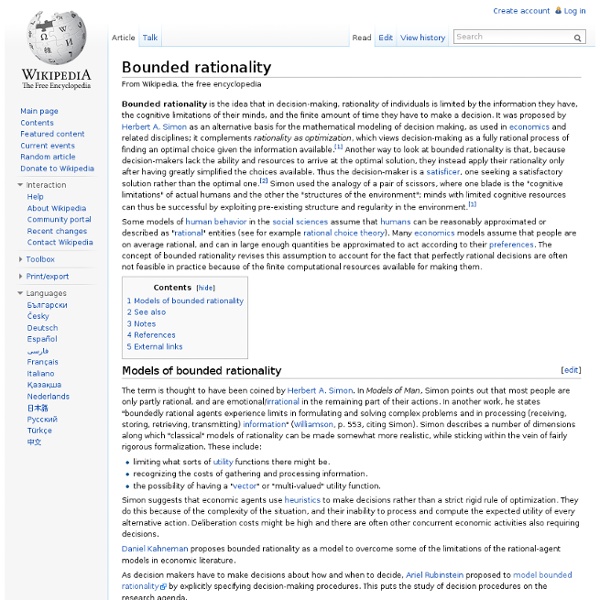Bounded rationality

Rational choice theory
Rationality is widely used as an assumption of the behavior of individuals in microeconomic models and analyses and appears in almost all economics textbook treatments of human decision-making. It is also central to some of modern political science,[2] sociology,[3] and philosophy. A particular version of rationality is instrumental rationality, which involves seeking the most cost-effective means to achieve a specific goal without reflecting on the worthiness of that goal. Definition and scope[edit] The concept of rationality used in rational choice theory is different from the colloquial and most philosophical use of the word. Early neoclassical economists writing about rational choice, including William Stanley Jevons, assumed that agents make consumption choices so as to maximize their happiness, or utility. Rational choice theorists do not claim that the theory describes the choice process, but rather that it predicts the outcome and pattern of choices. Formal statement[edit]
• Statista - The Statistics Portal for Market Data, Market Research and Market Studies
Best Free Schedule Maker Tool + Productivity Guide by Expert
April once struggled with her schedule, or the lack thereof. She works in ad sales at a large tech company in Manhattan. She used to hit her aggressive sales quotas year after year, but not anymore. The days of calmly and confidently representing her company and products were gone and so was fostering deep relationships with her clients. Those pressures infected April’s schedule. If you want to know what’s important to someone without asking them, where would you look? When it comes to using a schedule maker and planning your schedule, where do you begin? The trouble is, we don’t make time to live our values. Although each of us may subscribe to different values, it’s helpful to categorize them into three overlapping life domains. This concept is thousands of years old. More recently, Daniel Goleman, author of Focus: The Hidden Driver of Excellence, relates the domains of our life to how we split our attention.
Stages of PLN adoption
David Warlick wrote a post the other day about being able to zip up or turn off your Personal Learning Network (PLN). I too have been thinking about how one goes about starting a PLN, how do you monitor it, and how do you learn to shut it off. We all continue to push teachers to start PLNs if they haven’t already. Learning from the collective knowledge of educators around the world. I have noticed an emerging trend of what one goes through when adopting a PLN for the first time. As I’ve helped others start their PLNs I have found that many of them go through these same stages. Stages of Personal Learning Networks Adoption Stage 1 Immersion: Immerse yourself into networks. Stage 2 Evaluation: Evaluate your networks and start to focus in on which networks you really want to focus your time on. Stage 3 Know it all: Find that you are spending many hours trying to learn everything you can. Stage 4 Perspective: Start to put your life into perspective. [tags]PLN[/tags]
Related:
Related:



